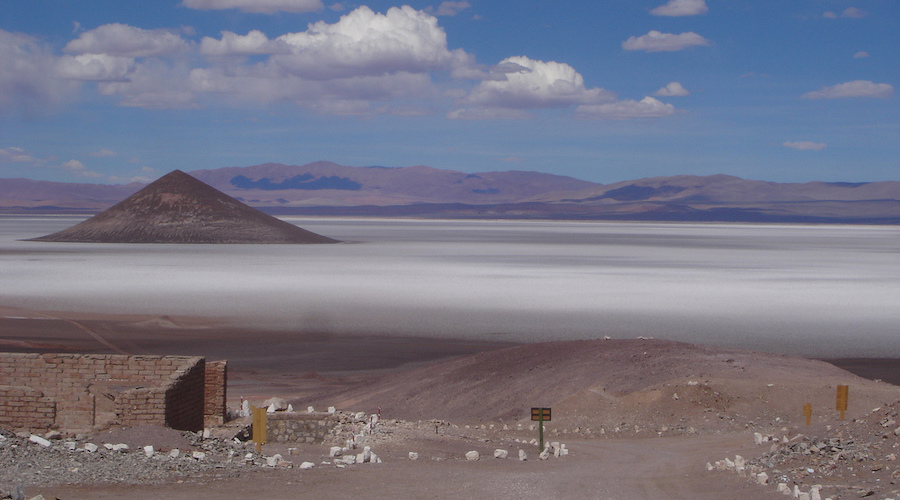
Nuclear scientists eager to add value to Argentina’s lithium bounty are being stymied by the country’s notorious economic problems.
For decades, the nation’s world-renowned atomic researchers have toiled on projects in Buenos Aires and Bariloche in Patagonia. Now, with Argentina emerging as the fastest-growing producer of lithium needed for the global shift to electric energy, they’re working on innovations to convert the battery metal into something scarcer than gold: lithium-6 isotopes that have key nuclear applications.
But the scientists spearheading these efforts are grappling with exchange-rate devaluations and capital controls — not to mention a new government under President Javier Milei, whose austerity drive includes shrinking federal funding for science.
Lithium-6 is needed to breed tritium, a rare element that may be crucial to the future of nuclear energy since it could feed a new generation of fusion reactors, including the ambitious ITER facility in France. The isotope is much more valuable than the lightly processed lithium carbonate that’s exported from Argentina’s Andean salt flats. Carbonate, used in electric-vehicle batteries, is worth about $11 a kilogram; the same amount of lithium-6 fetches tens of thousands of dollars.
Researchers pitched their project in 2021. But after authorities took time to approve it, they also faced months of red tape and further delays to import equipment. When they were finally ready to start work in earnest on lithium-6 last year, the plunge in the local currency had gobbled up the value of their budget. Milei’s 54% peso devaluation in December compounded the problem.
“At the end of it all we’re left with just one tenth of the original funding,” said Fabiana Gennari, the project leader who works in Bariloche with state nuclear energy agency CNEA. Gennari and her colleagues hope that speaking out will help attract fresh investment.
A similar story is playing out across the board for Argentine science programs that drew roughly $2 billion last year in government sponsorship. Budgets get sapped by a weaker exchange rate and by inflation that closely tracks the peso’s fall, despite some mitigation mechanisms.
It’s a dynamic that’s spawned all sorts of economic idiosyncrasies in Argentina: Savers rush to buy dollars, farmers hoard soybeans, and energy executives can find the numbers suddenly don’t add up.
Milei’s funding cuts are rubbing salt into the wound. CNEA has said it doesn’t have enough money to continue building two nuclear reactors, with workers taking to the streets this month to protest as the government’s funding allocation for science diminishes when measured against inflation.
The allocation has shrunk by one third this year, according Nicolas Lavagnino, who analyzes the science budget for think tank Ciicti. It’s set to decline slightly again in 2025, but would fall more precipitously if Milei doesn’t hit an ambitious target to slow inflation, Lavagnino said.
“We’re subjecting our scientists to a very tough test because they have it hard enough with the inherent uncertainty of research work,” said Fernando Peirano, who headed the government science agency that financed the lithium-6 project. “Add to that their exposure to Argentina’s macroeconomic and institutional instabilities, and it can leave great ideas stranded.”
An Economy Ministry spokeswoman didn’t reply to a request for comment on science funding.
For the lithium-6 project, CNEA is working with two other state atomic companies on ways to separate the isotope from the metal without using mercury, a dangerous pollutant that’s hard to dispose of.
The US stopped producing lithium-6 to develop nuclear weapons in the 1960s after struggles with mercury contamination in Tennessee. Today, only China and Russia still “enrich” lithium with mercury, and the world continues to hunt for ways to make the isotope cleanly on an industrial scale.
Gennari and her colleagues wanted to enrich lithium atoms with lasers. But there’s now insufficient money to buy them after the value of their funding shrank to roughly the equivalent of $100,000 from an original $1 million.
So the scientists have been left with trying electrochemical reactions, which are cheaper than using lasers. Even then, there are complications — a symptom, they say, of poor planning by politicians.
Their research laboratories have to import lithium from Asia at a time when Argentina is flooding global markets with the metal. “It’s very strange,” said Horacio Corti, “that we have some of the biggest lithium reserves in the world and yet we have to buy it abroad for our research.”
Corti tried to source the lithium from Argentina’s Jujuy province, a top-producing region, but it was a dead end. Jujuy has a preferential right to 5% of the lithium mined within its borders, but it’s unclear if authorities would exercise that option for projects outside the province.
“It shows a clear lack of an integrated national plan,” said his colleague Veronica Vildosola.
Milei, a libertarian outsider in his first year in office, may yet pose more risk.
The previous leftist government sought to maximize lithium’s economic benefits by encouraging battery development on home soil. But the new president prefers a hands-off approach, letting companies choose where they build supply chains.
Milei is also looking to sell some of the government’s stake in Nucleoelectrica Argentina SA, one of the companies involved in the lithium-6 project, as part of a privatization strategy.
While the goal one day is to supply nuclear fusion plants, Corti said there are plenty of other markets that Argentina could pursue in the meantime. Lithium-6 could, for example, be incorporated into protective layers around equipment used by nuclear scientists.
“We can use it in Argentina’s very own nuclear facilities,” Corti said. “That alone would justify the project.”
(By Jonathan Gilbert)
Comments